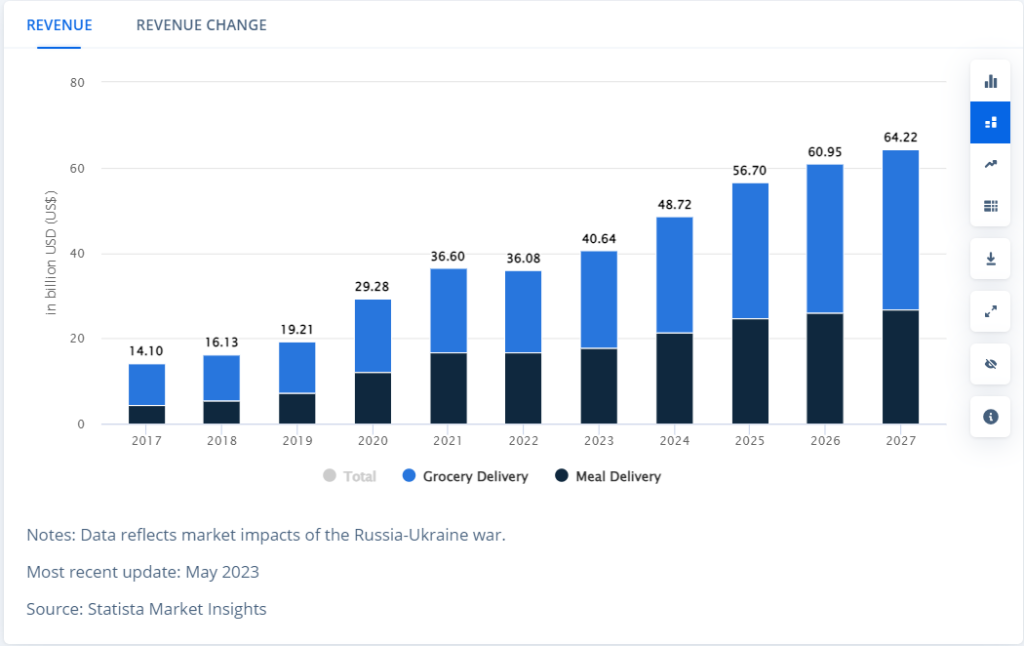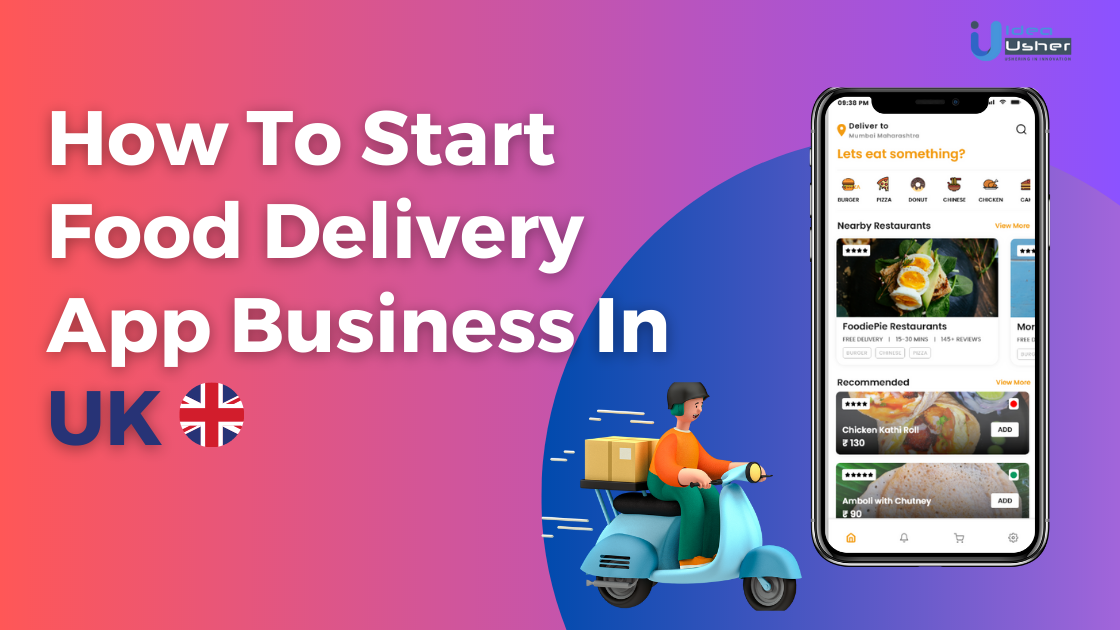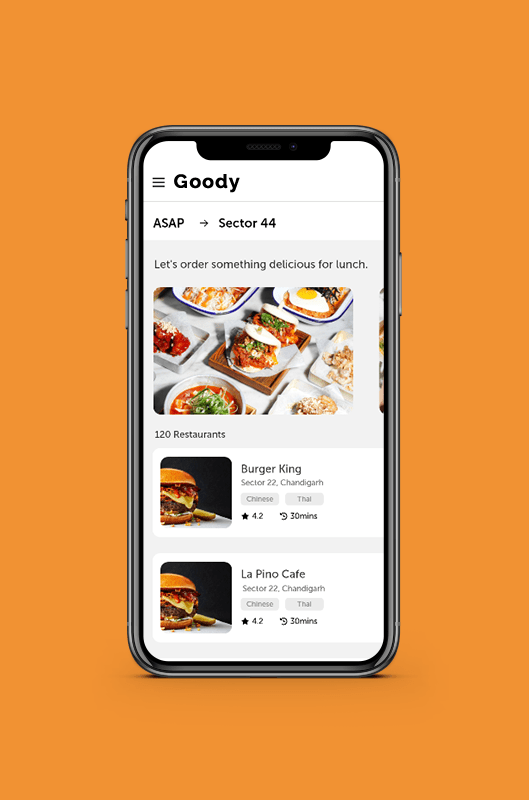The global food market is rapidly expanding, making online food delivery a necessity. In the UK alone, the number of people ordering food online has been steadily increasing, with every 5 individuals opting for this convenient service. If you’re interested in developing a food delivery application in the UK, this comprehensive guide will walk you through the process, from understanding the target audience to hiring a development team and considering the associated costs.

In terms of segments, the Meal Delivery segment is expected to experience substantial revenue growth of 20.7% in 2024. However, the largest segment in the UK market is Grocery Delivery, with a projected market volume of US$22.89 billion in 2023.
When compared globally, China is expected to generate the highest revenue in the online food delivery market, reaching US$395,900.00 million in 2023.
In the Grocery Delivery segment in the UK, the average revenue per user (ARPU) is projected to be US$0.95k in 2023. Meanwhile, the Meal Delivery segment is expected to have 50.58 million users by 2027, with a user penetration rate of 56.9% in 2023.
The food delivery industry is booming, and developing a food delivery app can be a lucrative venture in the UK market.
Who Needs a Food Delivery Application?
Here is small summary –
Food Establishments
Food establishments, such as restaurants, can greatly benefit from having a food delivery app. Statistics show that online orders through mobile food delivery apps generate an average of 23% more revenue compared to regular orders. By leveraging the right tools, this metric can be further improved. Additionally, the digitalization of the restaurant industry has been on the rise, and food delivery apps provide an ideal option for reaching customers who prefer the convenience of ordering food online.
Startups
Startups can also tap into the food delivery market by utilizing food delivery applications. These startups act as aggregators, partnering with multiple food establishments to provide users with a wide variety of options. By offering delivery services from various supermarkets or specialty stores, startups make it easier for people to buy food and save time. This model allows startups to generate revenue by receiving a percentage of the app usage from different establishments.
Types of Food Delivery Apps
There are three main types of food delivery apps: aggregators, logistics-focused, and full-cycle applications.
Aggregators
Aggregators are mobile applications that serve as platforms for selling and delivering food from multiple restaurants at once. They provide a catalog of restaurants, allowing users to explore various options and discover new establishments. Aggregators offer benefits such as marketing exposure for restaurants and delegated delivery services. However, they also come with certain drawbacks, including high commissions and a loss of control for restaurants.
Common examples of aggregator apps include Takeaway.com and Menulog, which serve Central Europe, Asia, and Australia respectively.
Logistics-Focused
Logistics-focused food delivery companies offer a similar user experience as aggregators, allowing users to compare different cafés, pricing, and cuisines. However, these companies also provide logistics support to the restaurants they collaborate with, eliminating the need for restaurants to have their own delivery services. Customers are charged set fees for these services.
Notable examples of logistics-focused apps include Just Eat, Deliveroo, and GrubHub, which operate in various regions such as Europe, North America, Australia, and Asia.
Full-Cycle
Full-cycle food delivery applications encompass both logistical aspects and restaurant management features. This type of app provides complete control over all activities and the client experience. By eliminating the reliance on third-party logistics or other restaurants, full-cycle apps offer financial viability and excellent adaptability
Swiggy and DoorDash are popular examples of full-cycle food delivery apps, serving specific regions and providing comprehensive services
Improving Your Food Delivery App Idea
To develop a successful food delivery app, it’s crucial to improve your app idea and make it stand out in the competitive market. Here are some key steps to consider:
Explore Market Trends and Opportunities
Conduct thorough research to understand the current market trends and identify potential opportunities. Analyze the preferences and behaviors of your target audience, and look for gaps or areas where you can offer unique value
Identify Unique Selling Points
Differentiate your app by identifying unique selling points that set it apart from competitors. This could include features like personalized recommendations, special offers, or exclusive partnerships with popular restaurants
Enhance User Experience
Focus on delivering an exceptional user experience. Ensure that the app is user-friendly, intuitive, and visually appealing. Streamline the ordering process, provide real-time updates on delivery status, and offer multiple payment options for convenience.
Key Challenges in Food Delivery App Development
Developing a food delivery app comes with its own set of challenges. Some of the key challenges to consider include:
- Competition: The food delivery market is highly competitive, with many established players. Differentiating your app and offering unique features is essential to attract and retain customers.
- Logistics and Delivery: Ensuring efficient delivery logistics, including accurate tracking and timely delivery, can be challenging, especially as the volume of orders increases.
- Restaurant Partnerships: Building and maintaining partnerships with a variety of restaurants requires effective communication and negotiation skills. Convincing restaurants to collaborate and ensuring a seamless integration of their menus and offerings is crucial.
Core Elements of a Food Delivery Application
When developing a food delivery app, certain core elements should be prioritized. These elements include:
User Interface and Design
A visually appealing and user-friendly interface is vital for a successful food delivery app. It should be intuitive, easy to navigate, and showcase appetizing food images. Clear categorization of restaurants and menus helps users find their desired cuisine quickly.
Payment Gateway Integration
Secure and seamless payment integration is essential to provide users with a hassle-free checkout experience. Offer multiple payment options, including credit/debit cards, mobile wallets, and digital payment platforms, to accommodate different user preferences.
Real-Time Order Tracking
Implement a real-time order tracking feature that allows users to track the status of their food delivery. This provides transparency and builds trust between the app and its users.
Ratings and Reviews
Include a ratings and reviews system where users can share their feedback and experiences with restaurants. This helps users make informed decisions and provides valuable insights for both restaurants and app administrators.
Customer Support
Offer reliable customer support channels, such as in-app chat or helpline, to address any user concerns or issues promptly. Excellent customer support contributes to a positive user experience and encourages user loyalty.
Must-Have Features for Food Delivery Apps
To ensure a seamless and user-friendly experience, incorporate the following must-have features in your food delivery app:
User Registration and Authentication
Allow users to register and create accounts easily using their email addresses, phone numbers, or social media accounts. Implement robust authentication mechanisms to ensure the security of user data.
Menu and Restaurant Search
Enable users to browse through menus and search for specific restaurants or cuisines. Implement filters and sorting options to facilitate an effortless search experience.
Ordering and Checkout Process
Design an intuitive ordering process where users can select items, customize their orders, and add them to the cart. Streamline the checkout process to minimize steps and offer a variety of payment options.
Delivery Tracking
Integrate a real-time delivery tracking system that provides users with updates on the progress of their order. This feature enhances transparency and reduces uncertainty.
In-App Payment Options
Offer various in-app payment options, such as credit/debit cards, digital wallets, and online payment platforms. Secure payment gateways ensure safe transactions for users.
Steps to Develop a Great Food Delivery Application
Follow these essential steps to develop a successful food delivery application:
- Market Research and Competitor Analysis: Conduct thorough market research to understand the target audience, their preferences, and the competitive landscape. Identify opportunities and gaps in the market that your app can leverage.
- Defining App Requirements and Features: Clearly define the app’s requirements based on your research findings. Determine the essential features, functionalities, and user experience elements that align with your app’s goals.
- UI/UX Design and Prototyping: Design an intuitive and visually appealing user interface. Create wireframes and prototypes to visualize the app’s flow and interactions. Iterate on the design based on user feedback and usability testing.
- App Development and Testing: Develop the app using a suitable technology stack and coding practices. Implement the defined features and conduct thorough testing at each development stage to ensure the app functions smoothly and bug-free.
- Launching and Marketing the App: Prepare a comprehensive launch strategy to create awareness and attract users. Optimize the app’s listing on app stores, implement app store optimization techniques, and leverage digital marketing channels to reach your target audience.
Hiring a Food Delivery App Development Team
When it comes to hiring a food delivery app development team, consider the following factors:
- Outsourcing vs. In-House Development: Decide whether to outsource the development to a specialized app development agency or build an in-house team. Consider factors such as budget, expertise required, and project timeline.
- Evaluating Development Companies: Research and evaluate app development companies based on their portfolio, client testimonials, expertise in mobile app development, and ability to meet project requirements.
- Technical Skills and Expertise: Ensure that the development team possesses the required technical skills, such as proficiencyin mobile app development frameworks (e.g., React Native, Flutter, or native app development), backend development, database management, and API integration.
- Communication and Collaboration: Effective communication and collaboration are essential for successful app development. Choose a team that demonstrates clear communication channels, understands your requirements, and provides regular project updates.
Food Delivery App Development Cost
The cost of developing a food delivery app depends on various factors, including the complexity of features, app design, development hours, and the location of the development team. It’s important to consider both the upfront development cost and the ongoing maintenance and support costs.
Conclusion
Developing a food delivery app in the UK can be a rewarding venture, considering the growing demand for online food ordering. By understanding the target audience, differentiating your app, implementing essential features, and following a well-defined development process, you can create a successful food delivery app. Remember to continuously adapt to market trends and user feedback to provide an exceptional user experience.
At IdeaUsher, we specialize in creating innovative and user-centric mobile applications, and we are excited to offer our expertise in developing a cutting-edge food delivery app for the UK market. Our team of skilled developers, designers, and project managers will work closely with you to bring your app idea to life.
By partnering with IdeaUsher, you gain access to our extensive experience in app development, deep understanding of the food delivery industry, and a commitment to delivering high-quality solutions. We prioritize user experience, security, and scalability, ensuring that your app stands out in the competitive landscape.
With our expertise in UI/UX design, backend development, payment gateway integration, real-time tracking, and other essential features, we are confident in our ability to create a standout food delivery app that exceeds your expectations.
Don’t miss out on the opportunity to revolutionize the food delivery experience in the UK. Contact IdeaUsher today to discuss your vision, and let us turn it into a reality.
Click below to get in touch
Work with Ex-MAANG developers to build next-gen apps schedule your consultation now
FAQs (Frequently Asked Questions)
Q: How long does it take to develop a food delivery app?
A: The development timeline depends on various factors, including the complexity of features, design requirements, and team size. On average, it can take several months to develop a fully functional food delivery app.
Q: Can I customize the app for my specific restaurant or food establishment?
A: Yes, food delivery apps can be customized to align with your restaurant’s branding, menu, and specific requirements. A skilled development team can tailor the app to meet your needs.
Q: How can I ensure the security of user data in the app?
A: Implement robust security measures, such as data encryption, secure authentication protocols, and regular security audits. Adhere to data protection regulations, such as GDPR, to safeguard user information.
Q: How can I promote my food delivery app to attract more users?
A: Utilize digital marketing strategies, such as social media marketing, search engine optimization (SEO), influencer partnerships, and targeted advertising campaigns. Encourage positive reviews and referrals from satisfied users.
Q: What ongoing maintenance is required for a food delivery app?
A: Regular maintenance is necessary to ensure the app’s performance, security, and compatibility with new operating system updates. It involves bug fixing, feature enhancements, server maintenance, and customer support.























